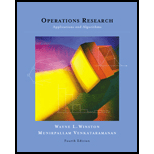
Explanation of Solution
Formulation of a Linear
From the given information, let consider “x1” bet the amount of money invested in bond 1, “x2” bet the amount of money invested in bond 2, “x3” bet the amount of money invested in bond 3, “x4” bet the amount of money invested in bond 4.
The objective is to maximize the expected return on its investments.
Therefore, the objective function is,
Maximize
Constraint 1:
At least, 8% must be the worst-case return of the bond portfolio.
Constraint 2:
At most, the average duration of the bond portfolio must be 6
Trending nowThis is a popular solution!

Chapter 3 Solutions
Operations Research : Applications and Algorithms
- A state university desires to accept only the top 15% of all graduating seniors who took their entrance test. This test has a mean of 500 and a standard deviation of 100. Assume the variable is normally distributed Find the probability that a person selected at a random will get a score greater than the mean of 500 but will not admitted to the university 15% 25% 35% 85% Find the cutoff score for the test 600 460 640 800 Which of the following statements about the normal curve is false? All variables that are approximately normally distributed can be transformed into standard normal variables The total area under the normal distribution is one The standard normal distribution is unimodal The normal distribution is a continuous random probability distributionarrow_forwardWhich of the following statements are true given A* (admissibility and consistency of heuristics ] ? The heuristic function h[n] is called admissible if h[n] is never larger than h*[n], namely h[n] is always less or equal to true cheapest cost from n to the goal. If the heuristic function, h always underestimates the true cost [h[n] is smaller than h*[n]), then A* is guaranteed to find an optimal solution. When h is inconsistent, it can not be admissible. If h is consistent and h[goal)=0 then h is admissible A* is complete and optimalarrow_forward
 Operations Research : Applications and AlgorithmsComputer ScienceISBN:9780534380588Author:Wayne L. WinstonPublisher:Brooks Cole
Operations Research : Applications and AlgorithmsComputer ScienceISBN:9780534380588Author:Wayne L. WinstonPublisher:Brooks Cole
